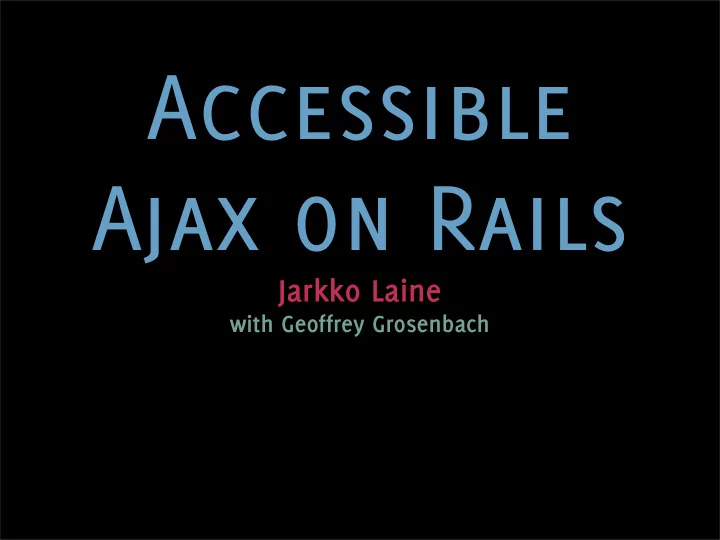

Accessible Ajax on Rails Jarkko Laine with Geoffrey Grosenbach
r.resources :categories do |cat| cat.resources :products cat.resources :companies cat.resources :subcategories do |sub| sub.resources :products sub.resources :companies end end
//<![CDATA[ new Form.Element.EventObserver(‘undone_box_1’, function(element, value) { new Ajax.Request(‘/items/1’, {asynchronous:true, evalScripts:true, method:‘put’, parameters:value + ‘&authenticity_token=’ + encodeURIComponent(‘8d829cfcccdf4d2b494891ef47cc95893faa361e’)})}) //]]> </script> </li> <li id=“undone_2”> <input id=“undone_box_2” name=“item[2][done]” type=“checkbox” value=“1” /> <input name=“item[2][done]” type=“hidden” value=“0” /> <label for=“undone_box_2”> Return bottles to recycling </label> <script type=“text/javascript”> //<![CDATA[ new Form.Element.EventObserver(‘undone_box_2’, function(element, value) { new Ajax.Request(‘/items/2’, {asynchronous:true, evalScripts:true, method:‘put’, parameters:value + ‘&authenticity_token=’ + encodeURIComponent(‘8d829cfcccdf4d2b494891ef47cc95893faa361e’)})}) //]]> </script> </li> <li id=“undone_3”> <input id=“undone_box_3” name=“item[3][done]” type=“checkbox” value=“1” /> <input name=“item[3][done]” type=“hidden” value=“0” /> <label for=“undone_box_3”> Return bottles to recycling </label> <script type=“text/javascript”> //<![CDATA[ new Form.Element.EventObserver(‘undone_box_3’, function(element, value) { new Ajax.Request(‘/items/3’, {asynchronous:true, evalScripts:true, method:‘put’, parameters:value + ‘&authenticity_token=’ + encodeURIComponent(‘8d829cfcccdf4d2b494891ef47cc95893faa361e’)})}) //]]>
Accessibility “the degree to which a product (e.g., device, service, environment) is accessible by as many people as possible.” -Wikipedia
Accessibility The ultimate goal
Progressive Enhancement A methodology for producing accessible web content
Progressive Enhancement Roots: graceful degradation hardly ever happened in real world
Progressive enhancement turns graceful degradation on its head build the essential, universal first then gradually enhance the experience for those capable of digesting it
Unobtrusive javascript part of the progressive enhancement process
Unobtrusive javascript Separation of concerns
Structure <div id=“wrapper”> <ul id=“my_stuff”> <li id=“hide_me”> I am Iron Man </li> </ul> </div> Presentation #wrapper { width: 100%; overflow: hidden; } #my_stuff { list-style: none; } #my_stuff li { padding: 1.5em; }
Structure <div id=“wrapper”> <ul id=“my_stuff”> <li id=“hide_me”> Behaviour I am Iron Man </li> </ul> </div> document.observe(‘dom:loaded’, function() { $(‘hide_me’).hide(); $(‘my_stuff’).observe(‘click’, Presentation function() { // do something }) }); #wrapper { width: 100%; overflow: hidden; } #my_stuff { list-style: none; } #my_stuff li { padding: 1.5em; }
Unobtrusive javascript Benefits clean and maintainable code —just like MVC in Rails
Unobtrusive javascript Benefits fits naturally in the progressive enhancement process
Unobtrusive javascript Benefits makes it easy for designers and programmers to work on the same code base
BUT Only (part of) a means
BUT Does not guarantee accessibility
<a href=“#”>Get bacon!</a> $(‘mylink’).observe(‘click’, function(e) { window.location = ‘http://google.fi‘; });
<a href=“#”>Get bacon!</a> $(‘mylink’).observe(‘click’, function(e) { window.location = ‘http://google.fi‘; }); Fully unobtrusive
Not accessible at all
Brief History of JavaScript on Rails
Brief History of JavaScript on Rails link_to_remote form_remote_tag
Brief History of JavaScript on Rails link_to_remote form_remote_tag absolutely fabulous
BUT...
2 problems
2 problems <form action=“/items” id=“add_form” method=“post” onsubmit=“new Ajax.Request(‘/items’, {asynchronous:true, evalScripts:true, parameters:Form.serialize(this)}); return false;” style=“display: none;”>
2 problems <a href=“#” onclick=“$(‘add_form’).toggle(); return false;”> Add new item </a>
reaction: UJS4Rails Dan Webb and Luke Redpath made Rails js helpers unobtrusive provided a method for attaching behaviours to elements
reaction: UJS4Rails heavy didn’t encourage people towards progressive enhancement
take two: Low Pro underlying JS framework behind UJS4Rails better to just use Low Pro than to mess with the Rails internals
Low Pro Event.addBehaviour() Behaviour “classes” DOM builder
Event.addBehavior({ ‘#add_form‘ : function() { this.hide(); }, ‘#add_new_link:click‘ : function(e) { $(‘add_form’).toggle(); e.stop(); } });
Behaviours Event.addBehavior({ ‘#add_form’ : Remote.Form });
Behaviours Event.addBehavior({ ‘#add_form’ : Remote.Form({ onComplete: doSomething }) });
DOM Builder $div({ id: ‘run-1’}, $p(‘A’, $em(“marathon”), ‘!’) ); <div id=“run-1”> <p>A<em>marathon</em>!</p> </div>
The bastard son var item = DOM.Builder.fromHTML( ‘<li>Remember to recover!</li>’); list.append(item);
CODE!
Event Delegation
The problems event handlers aren’t automatically assigned to dynamically added elements performance inversely related to the amount of elements
The problems Event.addBehavior({ ‘td:click‘ : function(e) { // execute some code for table cells } }); What if there are thousands of cells?
The solution lies in event propagation
*click* table *click* tr *click* td
Two event propagation modes event capture event bubbling
Event.addBehavior({ ‘table:click‘ : function(e) { // do something upon a table click }, ‘td:click‘ : function(e) { // execute some code for table cells } });
event capture *click* table *click* tr *click* td
event bubbling *click* table *click* tr *click* td
current W3C DOM spec supports both modes
as do all modern browsers
alas, not Internet Explorer
and thus, not Prototype either
so we’ll rely on event bubbling (which is totally fine)
So What? given that every event knows its target element (Event.element()) why not observe a higher-level element and only then work according to the original target?
enter Event Delegation made "famous" by Christian Heilmann with Yahoo! UI now "natively" supported by Low Pro, with Event.delegate()
Event.addBehavior({ ‘table:click’ : Event.delegate({ ‘td‘ : function(e) { var el = e.element(); // ... }, ‘a‘ : function(e) { e.stop(); // handle link clicks } }) });
CODE!
Caveats with event delegation not all events bubble up (most notably focus and blur) can kill performance in some cases (onmousemove)
Low Pro Behaviours
Low Pro Behaviours “Behaviours are an object orientated mechanism by which you can handle events and maintain the state of an element” -Dan Webb
var myForm = $(‘add_form’); var ajaxForm = new Remote.Form( myForm, { method: ‘post’ } );
Event.addBehavior({ ‘#add_form’: Remote.Form, ‘#ajax_link’ : Remote.Link });
Event.addBehavior({ ‘#add_form’: Remote.Form({ method : ‘put’ }) });
Behaviours bundled with Low Pro Remote.Form, Remote.Link Drag’n’drop Auto-completer In-place editor
...but the real benefits come from
...but the real benefits come from writing your own Behaviours to structure your JavaScript code
var Hover = Behavior.create();
var Hover = Behavior.create(); Object.extend(Hover.prototype, { initialize: function(className) { this.className = className || ‘over’; }, onmouseover: function() { this.element.addClassName(this.className); }, onmouseout: function() { this.element.removeClassName(this.className); } });
var Hover = Behavior.create({ initialize: function(className) { this.className = className || ‘over’; }, onmouseover: function() { this.element.addClassName(this.className); }, onmouseout: function() { this.element.removeClassName(this.className); } });
Event.addBehavior({ ‘.dongle’: Hover(‘hover’) });
Event delegation with Behaviours
Recommend
More recommend